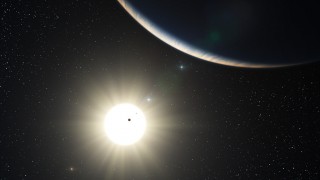
A new research study has revealed exoplanets that are similar to Neptune have the possibility of evolving into Earth-like planets. The report was directed by the University of Washington doctoral student Rodrigo Luger and research professor Rory Barnes. The study was recently published in the journal Astrobiology. The two study authors explained mini-Neptunes, as they have come to be labeled, can alter themselves into habitable planets.
Luger says there are numerous progressions that are minor on Earth but can disturb the habitability of M size dwarf planets. Two significant ones are sturdy tidal effects and forceful stellar activity. The habitability of such planets hinges on on the host star, which regulates the size and range of its habitable zone, on the basis of the size and mass of the star. The size and mass of such host stars, having exoplanets rotating around, were scrutinized by scientists to see if any of the planets were located in the habitable zone, according to United Press International.
The majority of the stars inside the Milky Way Galaxy are considered M dwarfs and they have small habitable zones with short ranges. The planets orbiting around them must be near enough so they remain warm and liquid water could remain on the surface in order to sustain life. This range is known as the Goldilocks zone around the star.
Mini-Neptunes may have dense atmospheres and might be located far from their host star, but with tidal forces occurring, they could migrate closer toward their own personal star, explained Luger. He stated that these planets are at first bitter cold, hostile worlds but they do not need to always stay in the same place in the universe. If they have tidal forces, those powers could possibly bring the planet inward through migration.
With relocation of such planets, the potent streams of radiation could push away the profuse gases that cover the planets, stated UPI, which would result in the appearance of habitable cores. On Earth, it is only the water of the oceans that becomes distorted at times, and that is only usually by a few feet. However, closed-in planets such as those located inside the habitable zones of M dwarfs, experience tougher tidal forces.
They also could have increased volcanism. That would be due to the result of the very strong tidal forces as well, and this just might have an end result of the release of huge amounts of material into the exoplanets atmospheres. When things such as this occur, it would cause greenhouse warming which would add to further global climate change of the planet. If the process continues, the oceans of the planets would eventually boil away completely and that would eliminate any chance of life beginning on these planets. However, to change into a habitable world, it takes a number of transformations to happen to the exoplanets before that would ever happen.
Even with all the changes that would need to occur, the possibilities are endless for future studies. The new research report revealed the exoplanets, which are similar to Neptune, have the potential of evolving into Earth-like planets. It is yet another exciting chapter in the world of astronomy.
